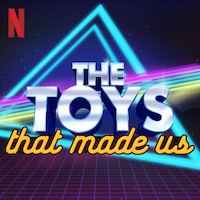| The Toys That Made Us | |
|---|---|
 Title screen | |
| Genre | Documentary |
| Created by | Brian Volk-Weiss |
| Directed by |
|
| Narrated by | Donald Ian Black |
| Country of origin | United States |
| Original language | English |
| No. of seasons | 3 |
| No. of episodes | 12 |
| Production | |
| Executive producers |
|
| Running time | 43-51 minutes |
| Production company | The Nacelle Company |
| Original release | |
| Network | Netflix |
| Release | December 22, 2017 – present |
The Toys That Made Us is an American documentary television series created by Brian Volk-Weiss. [1] The first four episodes of the series began streaming on Netflix on December 22, 2017, [2] and the next four were released on May 25, 2018. [3] The eight-episode documentary series, as it was originally touted, focuses on the history of important toy lines. The first four episodes focus on the Star Wars , He-Man, Barbie, and G.I. Joe toy lines [4] [5] with subsequent episodes featuring LEGO, Transformers, Hello Kitty, and Star Trek , [6] which aired on May 25, 2018. [7] On July 19, 2018, it was announced at San Diego Comic-Con that the show had been picked up for a third season, with episodes featuring Power Rangers , professional wrestling, My Little Pony, and Teenage Mutant Ninja Turtles , and was released to Netflix on November 15, 2019. [8] [9]
Contents
- Episodes
- Series overview
- Season 1 (2017)
- Season 2 (2018)
- Season 3 (2019)
- Season 4 (TBA)
- Season 5 (TBA)
- References
- External links
In November 2019, Netflix released a spin-off series, The Movies That Made Us , focusing on the development of classic films. [10] In July 2024, Nacelle announced that the show was renewed for a fourth and fifth season, with episodes featuring Superhero Toys, Nerf, Pokémon, American Greetings, Hot Wheels, Ghostbusters, Polly Pocket, and Fast Food Toys. [11] [12]


